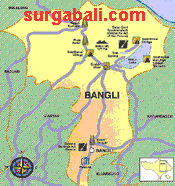Bangli Regency - Bali

The cool, mountainous regency of Bangli was long fought over
by rulers from neighboring kingdoms, for here lies
Lake Batur, the major source of irrigation water for most
of South and East Bali and parts of the north. The ruling house
emerged during the early years of the Klungkung kingdom during
the 1700s to which it is related.
In the mid 1800s Bangli sought Dutch protection from Klungkung,
Karangasem and Buleleng, but by the end to the 19 century it was
joining its former enemies against powerful
Mengwi to the west Due to its early recognition of the Dutch
Bangli was spared during the conquest of South Bali in the early
1900s. The steady ascent through Bangli passes through tidy villages
and roads lined with groves of bamboo and coffee.
In Bangli town the ancient Kehen temple is under a huge banyan
tree. Celebrations feture ritual basis warrior dances with different
weapons, and towering offerings fill the court yards every 3 years.
Nearby is the Sasana Budaya art Center with occasional art exhibitions
and performances. The view beyond the town Bukit Demulih is breathtaking.
An interesting village is Penglipuran, with its neatly terraced
street.
Higher up on Mount Batur at Penelokan are spectacular views of the active volcanic
cone and peaceful lake below. In the village of Kintamani
is Pura Batur, a huge complex of temples for the Lake goddess,
perched on the crater rim. Beyond the village in Penulisan is
Tegeh Koripan temple, an ancient and mysterious temple often hidden
by mist and reached by a long flight of steps. A winding road
leads down into the crater to the soothing Toya Bungkah hot springs
at the edge of lake Batur.
The Bali Aga people who dwell in the village of Trunyan,
located at rim of Batur Lake have a rather unique custom in treating
the body of the deceased. They simple leave the body on the ground
to decompose naturally. Hiking up the volano is possible. The
Balai Seni art Center has spacious gardens and a library. A cross
the lake is Trunyan where the dead are lift exposed to the elements.
Visitors may see this cemetery but not the hugs statue housed
in a towering pagoda in the village. A rarely held festival features
then ferriswheeels and masked dancers who whip by standers.














